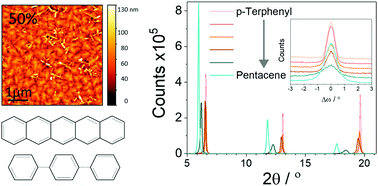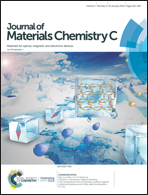Growth, morphology and structure of mixed pentacene films†
Abstract
Thin films of pentacene and p-terphenyl were grown via organic molecular beam deposition to enable solid-state dilution of functional molecules (pentacene) in an inert matrix (p-terphenyl) at higher concentrations than permitted by traditional crystal growth methods, such as melts. Growth rates were first optimised for single component films to ensure a precise control over the dopant/host concentrations when the mixed films were deposited. Both thin film and bulk phases can be identified in pentacene growths, with the precise lattice parameters dependent on the deposition rates. The effect on the microstructure, resulting from progressive dilution of pentacene in a p-terphenyl host, was then investigated. Although disorder increases and the crystallite size decreases in the mixture, with a minimum at a 1 : 1 ratio, phase segregation is not observed on the length scale (limit) that can be probed in our measurements. This indicates that the mixed films form homogeneous solid-solutions that may be employed for the investigation of solid-state phenomena. Our methodology can be extended to other compatible host-dopant systems used in optoelectronic and spintronic devices.

- This article is part of the themed collections: Journal of Materials Chemistry C Advisory Board Collection and Editor’s Choice: Progress in singlet fission and photon upconversion


 Please wait while we load your content...
Please wait while we load your content...